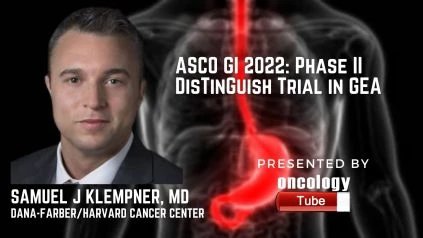Samuel J Klempner, MD a gastrointestinal medical oncologist with a clinical and research focus in upper GI cancers, specifically gastroesophageal cancers at Dana-Farber/Harvard Cancer Center. In this video, he speaks about the ASCO GI 2022 Abstract – DKN-01 and tislelizumab ± chemotherapy as a first-line (1L) and second-line (2L) investigational therapy in advanced gastroesophageal adenocarcinoma (GEA): DisTinGuish Trial.
Â
Origins:
Despite the recent approval of anti-PD-1 antibodies as 1L therapy in HER2(-) advanced GEA, the benefit is minimal and limited solely to PD-L1(+) patients (pts), primarily those with CPS 5. As a result, novel therapeutic techniques for this patient population are required. DKN-01 is a targeted anti-DKK1 monoclonal antibody that has been shown to enhance clinical outcomes in patients with increased tumoral DKK1 expression, a subpopulation of patients with more aggressive disease, and shorter overall survival.
Â
Methodologies:
Part A of DisTinGuish (NCT04363801) looked at DKN-01 (D) Plus tislelizumab (TS) + CAPOX as 1L therapy for patients with advanced HER2(-) GEA regardless of DKK1 status, whereas Part B looked at two dose cohorts of D (300 mg and 600 mg) + TS as 2L therapy for DKK1-high advanced GEA patients. The study’s primary goal was to look at safety and tolerability, while secondary goals looked at numerous efficacy endpoints like overall response rate (ORR) in a modified intent to treat (mITT) group (>1 dose D).
Â
Outcomes:
49 points enrolled between September 1, 2020, and September 15, 2021; 25 points in Part A and 24 points in Part B. (D-300 mg). The table shows the key clinicopathologic features and efficacy outcomes. Low grade (G1/2) weariness, nausea, and diarrhea were the most common D-related AEs. D-related G3 toxicities occurred in nine patients, including high AST/ALT, raised alkaline phosphatase, hypophosphatemia, hyponatremia, lymphopenia, neutropenia, diarrhea, vomiting, and lethargy in one patient, and pulmonary embolism in two patients (one G5 event). Parts A and B1 revealed no new safety signals. Part A’s duration of response (DoR), median PFS, and median OS has yet to be determined. On September 15, 2021, the last pt enrolled in Part B1.
Â
Findings:
D/TS + CAPOX is a well-tolerated, active 1L combination, especially in DKK1-high patients, which is in line with the postulated mechanism of action. The presence of PD-L1 does not appear to affect activity. Biomarker enrichment and efficacy are linked in Part B1, and biomarker data will be given alongside revised Part A efficacy data. NCT04363801 is the number for the clinical trial.

